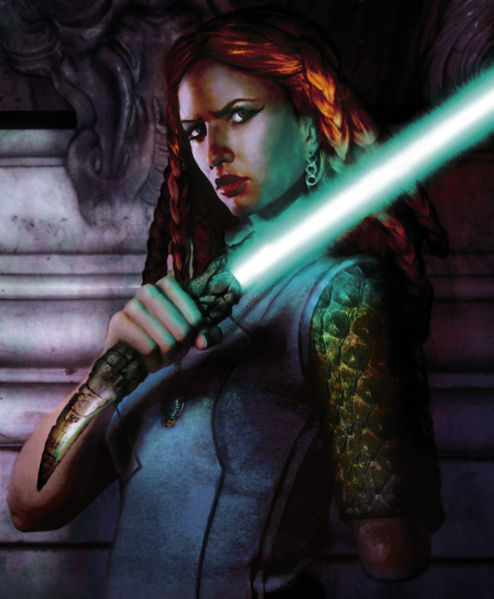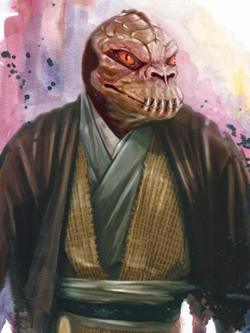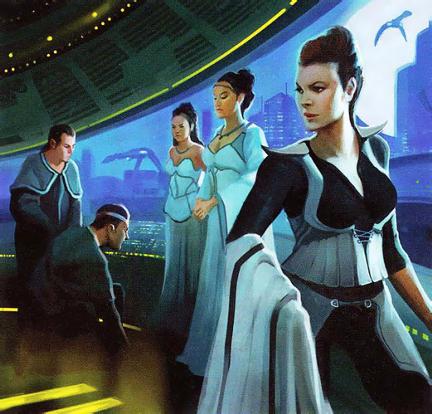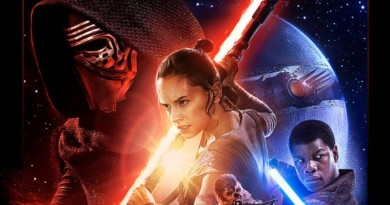Blood, Honor and Matriarchs: The Hapan Women of Star Wars – Part Three
FANgirl’s Note: Over a year and a half ago, Racheal, Kay, and I embarked on a conversation about the Hapan women of Star Wars, and the potential we saw in their backstory. When the series kicked off, we were excited for it, and it’s been a popular post. As we were finalizing the second part, Racheal died in a car accident. We posted Part Two in July of 2012 and took a break from the discussion. That post sits on the top ten most viewed list alongside Luke Skywalker Must Die and Does Slave Leia Weaken or Empower Women? A couple of months ago, B.J. joined Kay and me to start the wrap-up of this discussion. Along the way, Kay noted her frustration that the topics still needs discussion, which mirrors the sentiments of B.J. and I. With the fandom conversation recently focusing on diversity and Lucasfilm blazing a new trail for Star Wars, there was no time like the present – and perhaps Racheal was giving us a little nudge – to revisit the Hapan women of Star Wars.
First, it’s worth restating the original goals of the Hapan post series:
Genre storytelling has to be a little rough around the edges because it reflects the realities of the world the audience lives in. When historians look back on this era, undoubtedly its fiction will expose the biases and conflicts that defined us. Nonfiction studies such as Jennifer K. Stuller’s book Ink-Stained Amazons and Cinematic Warriors or Gail Simone’s Women in Refrigerators webpage will give insights into how a broad range of storytelling across entertainment mediums reveal truths about the society that produced and consumed them. The success of Star Wars, Star Trek, Harry Potter, Twilight, and The Hunger Games all say something about who we are and what we want to be. Ultimately, that fiction may have the power to change us as a people more than anything else.
After covering the Hapan culture, their distrust of the Jedi, and their sexism in Part One, the second part explores two prominent Hapan characters, Tenel Ka and her daughter Allana, who both happen to be Jedi. While listening to a Star Wars Bookworms interview, I realized there was a reason to continue the conversation from the fandom/customer side. In his interview, author John Jackson Miller discussed his views on gender and diversity in Star Wars. He said (approximately 33:30 in the interview):
“Gender issues have no real role in Star Wars because it’s not part of – women’s suffrage and the equal rights movement, that’s part of our history, that’s not part of their history. I sort of feel the same way when we get into questions of race in Star Wars, or things that would be an issue here are not really an issue there. Black, white, brown – these are questions for us, but they’re not really questions in a world in which the options for skin color include green, include blue. Diversity in Star Wars means do we have enough Wookiees in the scene? Do we have members of these other species from other planets?”
Miller is well-regarded for his portrayal of Zayne Carrick and other characters in the Knights of the Old Republic comics, and he wrote the Knight Errant novels and comics that headlined Kerra Holt. Because he has given female characters better opportunities as a creator, it was interesting to hear his view on gender and diversity. Obviously he is entitled to that opinion as a creator, but based on discussions from TFN Literature forum Diversity thread, Eleven-ThirtyEight’s diversity post, the discussion on diversity at the Star Wars Books Facebook page, and from our discussions earlier in this series, it seems many fans have a different take on gender issues and diversity in Star Wars. Everyone brings their own “point of view” to Star Wars, and fans have been asking for more perspectives in the storytelling. We value hearing the creators’ and editors’ opinions because it can help enlighten us on how they approach storytelling. Essentially that statement was a reminder to me that fans need to remain proactive in their approach and ask for Star Wars to consider the how’s and why’s of the storytelling process.
The roundtables don’t exist to tell anyone their opinion is wrong, just that some people see things differently, have experienced Star Wars differently, and would like to challenge the franchise to understand those perspectives because, in the end, we believe that will result in better storytelling.
Statements by Kathleen Kennedy and the Lucasfilm team at Celebration Europe II indicate a recognition that the fans’ collective consciousness about the brand does matter. In his explanation, Miller combines gender issues with racial diversity concerns. Do you think they can be approached as a singular issue?
Kay: They don’t have to but they could be addressed in one go. I struggle with the idea that it has to be such a conscious, efforted decision to represent (and represent well) female and non-white characters in a story universe like Star Wars because it should be happening naturally already. I mean, the diversity is all right there ripe for the picking. So many types of different sentient beings and cultures have already been created — some with rich backgrounds ready for application and some with sparse backgrounds waiting to be fleshed out. So I wonder how a storyteller in Star Wars could not have inclusion and the first answer that pops into my mind is are they just writing what they know? Maybe that storyteller doesn’t have a lot of personal experience with diversity. But I honestly think it’s not that difficult to include diversity in Star Wars — whether it’s gender or race.
B.J.: They’re a singular issue from the perspective of the question, “Is there a reason this character needs to be a white male human?” If it’s a canon character like Luke or Anakin, Han or Wedge, then the answer is yes. For almost any original character, though, the answer is usually no. Even Imperial officers, who are basically white British guys in the movies, have been created with more diversity in the EU, including women and aliens.  So it’s good if Star Wars creators can break past the impulse to set white male human as the “default” character type, because then a more diverse cast should follow from that.
So it’s good if Star Wars creators can break past the impulse to set white male human as the “default” character type, because then a more diverse cast should follow from that.
Tricia: Following up on what B.J. said, with the movies coming up, characters people already know and love could get brought over from the Expanded Universe. That creates two issues – first, many of them are white male, and second, many of them are white women. With that said, perhaps the casting and storytelling process for the movies is the perfect place to challenge the status quo. Does Mara have to be white? Or a character like Kyle Katarn or Dash Rendar? If the Skywalker-Solo children have friends, why not shake up the race on one or more? How about an Asian Tahiri, Indian Tenel Ka, or Latino Zekk? In the 2012 Valentine’s Day artwork, Jag was a person of color.
In my opinion, I still see a disconnect between what some members on the Star Wars storytelling team perceive as representing diversity and what fans would like to see, which is that they want characters like them. Psychologist Andrea Letamendi presented her study on cosplay at GeekGirlCon, and she pointed out that a lack of racially diverse characters inhibits the ability for many fans to connect with characters and that is reflected in the lack of racial diversity among cosplayers. Like Kay, I find it a bit frustrating that more creators don’t make a conscious effort to diversify among their humanoid characters. Since it’s not natural for some storytellers, I think the two have to be separate issues when reviewing a story outline. We’re still at the point where both questions – “Are we providing enough racially diverse characters?” and “Are we providing enough gender diversity?” need to be asked by the Powers That Be. And while creating a female person of color gives positive marks to both questions, if that is all that is done it can still be perceived as tokenism.
As Kay astutely asks, “are they just writing what they know?” This to me is still the problem. Jane Espenson and Eli Gonda said it best in their interview with Fan Voice. So long as the list of producers, writers, and comics creators is skewed heavily male, it will be difficult to infuse different perspectives into the storytelling. While superficially some concerns have been addressed in the book s and comics particularly, there are still many opportunities to do even better. One of the most positive signs that Lucasfilm is embracing these questions is the inclusion of Diana Williams on the Story Group, who has no problem expressing her opinions about diversity and the status quo of Hollywood on Twitter.
While editing the post news broke on USA Today about Star Wars Rebels, including footage of three female creators talking about the character Kanan. The characters voice actor Freddie Prinze Jr. speaks Spanish and is an American melting pot of Puerto Rican, German, Irish, English and Native American descent. I’ve been critical of the franchise on this regard, so it was a positive sign.
Previous statements from members of the Star Wars Books team regarding diversity have pointed to characters like Saba Sebatyne as an example of a female character who also represents diversity. Does a Barabel, Wookiee, or other alien in a story address your concerns about diversity in Star Wars?
Kay: It depends. In the optimal situation a character being a Wookiee or a Gamorrean or whatever type of alien the character is makes the story stronger. It brings another perspective and/or another challenge or strength to the group of characters. Throwing in a Wookiee just so you can say there’s a Wookiee might technically add to the diversity but it isn’t necessarily helping the story. But this goes for any character — it weakens the story if the character could easily be replaced by any random character and it wouldn’t have much if any of an effect. It’s better when a character’s background or culture contributes, even when what it contributes is to show that regardless of what a being looks like on the outside or where they started, they can still be a hero… or a villain.
B.J.: It’s important to consider that the primary impact of diversity in the cast of characters often isn’t to mirror real-world inequality, but rather to increase the relatability and accessibility of the characters and the story for the readers or audience. At times, of course, fiction can be a great method for getting people to recognize injustices or subconscious prejudices that they might not have seen otherwise. But assuming that diverse characters exist mainly as lenses on social justice issues is really misunderstanding the point. Research shows that young people who see “faces that look like me” in books or comics, television or movies, are more easily able to connect to those characters and feel inspired by those stories. A female character who never actually experiences gender bias in the story, or a non-white human character who never experiences racial discrimination (or an alien who doesn’t confront any anti-alien bias), is still a powerful representative figure. And a Barabel or a Wookiee, while not a white male human face, isn’t a “face like me” for very many Star Wars fans.
Tricia: Many fans, including myself, don’t believe that “there are enough Wookiees or Barabels in a scene” creates diversity. First of all, Wookiees don’t generally have dialogue, nor do we get to see inside their heads. They can have feelings or go through emotional arcs, but by design of the character it is almost impossible to create a connection that is relatable. We see Wookiees as faithful, loyal, brave – all things that are aspirational and heroic – but the subtler emotions than really flesh out a character are lost in “Rweorrr-roar-uh-uh-uh.” Saba Sebatyne was offered by Shelly Shapiro as an example of diversity. Perhaps the character is not a white male, but she is also by design entirely alien in her thought process. Physically dominating over any human, Saba isn’t a character that encourages people to get into her skin because we as humans aren’t as strong as her, nor do we think like her. That’s not to say an alien character can’t be relatable – take Piggy and Runt from Wraith Squadron, who feel very human, yet maintain that unique sense of alien in their personalities.
Specifically on gender issues – including sexism, women’s suffrage, and the equal rights movements – how do you see their impact on the Star Wars narrative? This might include impacts in the movies and in other mediums, as well as in-universe and out-of-universe.
B.J.: At least in the movies, gender inequality isn’t a theme of the in-universe narrative. Perhaps there could be an implication from the relatively few actresses cast in the Original Trilogy, but when the Prequel Trilogy is considered as well it doesn’t appear to me that George Lucas was working a gender inequality allegory into the films – especially because some of his political and military allegories are expressed pretty clearly. On the other hand, the out-of-universe impact of Princess Leia in the 1977-1983 timeframe can’t be overestimated. The attempted Equal Rights Amendment to the U.S. Constitution had started the ratification process in 1972 and formally failed to achieve ratification in 1982. One reason her character resonated so powerfully at the time was because she represented the kind of success women can achieve when society and the law aren’t holding them back.

Kay: Of course the Star Wars universe itself is a huge galaxy full of different cultures with different resources, development, and values. So there’s plenty of possibility for movements with similar beginnings to or elements of real-world ones to happen. I agree with B.J., though, that I didn’t see an overt attempt to represent the gender equality struggle in any of the Star Wars films. But I remember watching the original trilogy as a kid and admiring Leia’s strength of character. No one ever told her in those movies that she couldn’t do something because she was a girl. It was beyond gender when she was equally a threat to the Empire and a boon to the Rebellion and that’s because of her tenacity. To this day she’s a nice reminder in my mental arsenal of how far you can go with resolve
Tricia: Sexism is a form of oppression. The women’s suffrage movement and the equal rights movement fought that oppression; it was a rebellion. Slavery is an ongoing theme in Star Wars. Racism and sexism is a subtext of the movies, simply because the Empire is all white men. The Expanded Universe ran with that notion as Thrawn and Daala moved through the bigoted Imperial hierarchy. Jabba is affirmatively a sexist, which probably makes his throttling by Leia while using her chains of bondage all the more satisfying for women. Between Jabba’s palace and the pre-podracing scenes in Episode I, it’s arguable a feminist equal rights movement is necessary on Tatooine. Then there is the matter of the out-of-universe portrayal and use of Slave Leia and midriff Padme in media that creates an impression of sexism, or at least a double standard, within the franchise. It’s also undeniable that there are a limited number of female characters playing integral parts – The Phantom Menace being a lone standout within the cinematic storytelling.
The galaxy far, far away is an enormous storytelling universe, where all forms of oppression are possible. The Expanded Universe picked up on this possibility early on, using the Dathomir witches and Hapan culture to explore conditions where women oppressed men. The Dathomir witches were utilized in The Clone Wars and the Zygerrian arc explored slavery, with Anakin being taken captive by the Queen and Ahsoka subjected to attire that sexualized her. So sexism exists in Star Wars, whether it was created by outside influences in how storytellers and artists visualized their worldbuilding in either a subconscious way or in deliberate manners. I’m not opposed to using sexism, racism or any other oppressive mindset in a story so long as the storytelling team is aware that is what they are creating and considers the potential ramifications for the story and the audience.
Another important point to make is that fiction draws heavily on events of upheaval like genocidal extinction, the rise of dictators, and the resistance against them. Star Wars, in particular, depicts conflict at the galactic level in the Original Trilogy and a more personal level in the Prequel Trilogy. Women’s suffrage or the equal rights movement are more tools to understanding the ways one group can oppress another, and how the oppressed can resist and even rise above that situation.
Coming soon, Part Four will conclude the series with our discussion of Taryn Zel and other female characters, and the fate of Blood Oath.
Currently a tenured law professor in Florida, B.J. has been a practicing lawyer in Washington, D.C., a law clerk to a federal appeals court judge, and a law journal editor-in-chief. He is also a proud geek dad whose son who is a big fan of Star Wars and The Clone Wars. You can contact him by email at lex@fangirlblog.com.
Kay grew up wanting to be an astronaut. After seeing Star Wars, she wanted to be Princess Leia, Han Solo, and an astronaut. Life’s taken her on a bit of a different path for now, but she’s still a Star Wars fangirl at heart who enjoys surprising people with how geeky she really is. Currently a photographer who also specializes in communications and marketing, Kay spends her free time reading, cooking, writing, learning and, of course, making pew pew noises. You can follow her on Twitter.
- Let’s Win the Season of the Force Scavenger Hunt - April 10, 2024
- Hyperspace Theories: Metamorphosis and Sacrifice in The Bad Batch Season Two - March 22, 2024
- Fangirls Going Rogue: The Bad Batch Returns - March 1, 2024











–Gender issues have no real role in Star Wars because it’s not part of – women’s suffrage and the equal rights movement, that’s part of our history, that’s not part of their history.–
From the list of known Supreme Chancellors of Old Republic (31, incl. Palpatine) only 3 are women. 7 unaccounted for, but I have my doubts about their gender. About ten of all Chancellors are human, including two of women Chancellors (humans are the only race, which had more than 1 Chancellor). So, no gender issues, they say? Like, none at all?
And there are a lot of things like this that show us that there were no gender equality in a galaxy far far away. Because it’s all good and well that authors have some women as main heroes of stories, but the galaxy background is still… well in dire need of suffrage.
Sorry for the language, I’m not an English-speaking person.